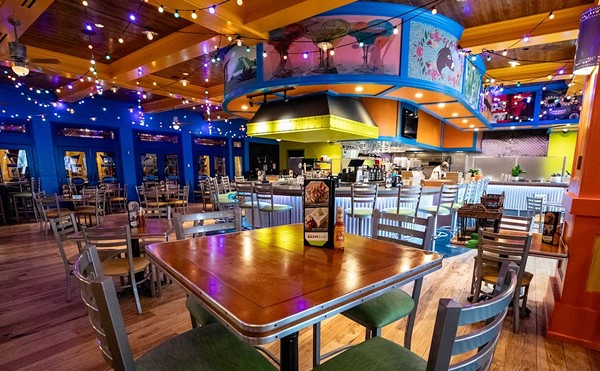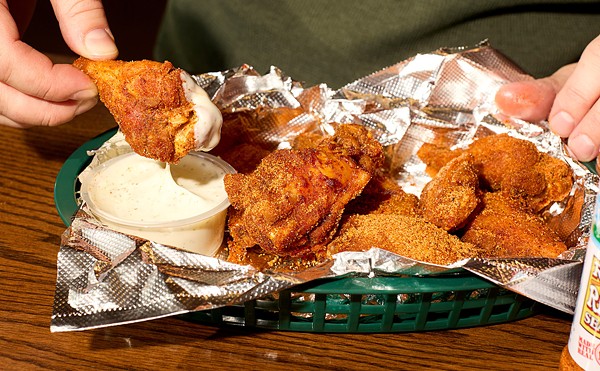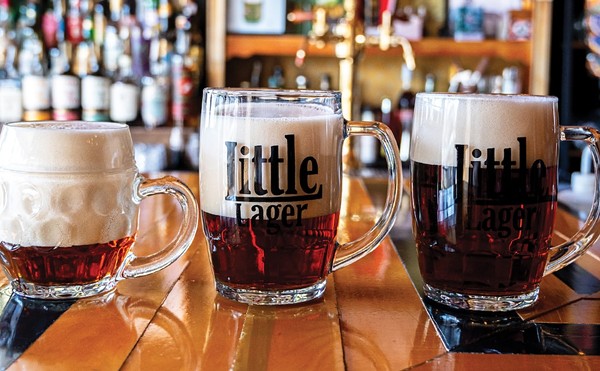Sounds like parody, but it's not. This is truly what you get when you dine at the restaurant that became the most spangled feather in St. Louis' fine-dining cap the instant it hung its shingle in the Renaissance Grand downtown in late September. An American Place is the signature establishment of renowned chef and cookbook author Larry Forgione; the original debuted in 1983 on Manhattan's Upper East Side, branded celeb-chef status upon Forgione (rare before the advent of the Food Network) and garnered three stars from the New York Times.
Forgione's arrival in St. Louis has been huzzahed by many but truly appreciated by few. The typical conversation on the subject, even among those considered in-the-know, goes something like:
"Hey, did you hear they're opening An American Place downtown?"
"Yeah, the chef is, like, this big guy from New York!"
"Yeah!"
It is a big deal that a big guy from New York opened a restaurant here, but not just because we get to brag about the coveted Saturday-night dinner reservation we nabbed or the $32 strip steak we ordered. Trained under American-cuisine prophet James Beard, Forgione was one of the first high-profile American restaurant chefs to unabashedly embrace his homeland's cuisine and to recognize that its potential lay in using fresh, seasonal, regional ingredients. Before folks like Forgione came along, most restaurateurs were at the mercy of the same distributors that supplied processed foods and lesser-quality meats and produce to supermarkets. Forgione dealt with farmers directly, setting his own standards and making his own demands regarding how ingredients should be cultivated and raised. Displeased with the poultry he found for sale, he -- no kidding -- invented "free-range chicken" when he helped found the first such farm in Warwick, New York. Whole Foods -- not to mention every urban farmer's market that's started up in the past decade -- owes Forgione and his ilk a debt of gratitude.
When you see that An American Place's menu changes night by night and lists its purveyors -- most of them Missouri and Illinois farms -- alongside its tantalizing dishes, and when you hear a waiter dictate the life story of a pork chop, it may seem gimmicky. Truly, these are hallmarks of what makes dining at An American Place a superb experience.
Superlative, too: Forgione's food tastes as good as you thought it could possibly get -- and then some. The oceanic sweetness of a scallop (here, gathered one by one by divers in Maine and accompanied by Oregon wild mushrooms, fennel and an ethereal truffled celery root) tastes exponentially, and somewhat inexplicably, more. A rack of grass-fed Missouri lamb, cooked to a perfect medium, resounds with bloody-good, lip-smacking deliciousness. Chowders, bisques and cream-based soups hit the tongue like pure velvet, and then, just as quickly, airily vanish.
Pasta, in appetizer- or entrée-size portions, is treated reverentially. One bite of pappardelle with veal ragout and your consciousness instantly swipes over, Being John Malkovich-style, to the dear calf's frame of reference, envisioning the hours of slow-roasting it must have endured so it could die for your gluttonous sins. The whole-wheat lasagna is a surprise treat: light sheets of pasta tempered with delightful cauliflower florets and lovely layers of roast pumpkin and heirloom bean purées. An off-menu truffled pasta, with white Oregon truffles razored (at the table) onto a glorious pile of creamy, leek- and pancetta-tossed tagliatelle, showcases the exceptional fungus at its aromatic, aphrodisiac best.
An American Place is at its best when reinventing, reintroducing or rediscovering foods that don't have crowd-pleasing reps. Like elk, marginally consumed at best, which comes from the Carmack Elk Farm outstate in Glasgow and imparts a rustic, musky savoriness. It's served with sautéed Brussels sprouts and a purée of roasted parsnips. The parsnips are remarkably sweet (the root's starches convert to sugar at the year's first frost). The parsnips taste like butterscotch pudding. The parsnips are too good to be true.
Veal mignon with potato gnocchi was darling -- and exposed An American Place's Achilles heel. The veal was about the size of a flip phone. Part of each server's introductory homily, in addition to imparting that the food is 100 percent organic, serves to warn that appetizers are sized at two to three ounces apiece, entrées about five ounces. This isn't always an issue -- the aforementioned lamb and elk, plus a tasty pork chop served with green lentils and braised savoy cabbage, were ample servings. What's more, small portions nicely allow for a four- or five-course meal without the risk of bloat -- all the better if you're not stuffed before dessert and the cheese course.
But there's small, and then there's small. Forget the stereotype of the all-you-can-eat Midwesterner in search of mammoth slabs of food. It's just that when you order, say, a lobster martini appetizer -- Maine lobster salad served in a martini glass, drizzled with a dressing of lemongrass and sake that's poured from a martini shaker -- you want to see lobster, not go foraging through tufts of microgreens to find it. You want to be able to enjoy a few bites of your course, let your dining mates try a bit as well, and maybe even relish one more mouthful before surrendering your cleaned plate to the attentive (but unobtrusive) server. Likewise, when the "pork and beans" appetizer adorably pairs a quartet of unsmoked bacon stubs with a teeny-weeny cast iron skilletful of baked butterscotch beans, sweet onion purée and sweet potato sauce -- let's just say sometimes more is, well, more.
The wine list embodies more-is-more. It's about 150 selections strong and all-American, almost exclusively from California. It's also less intimidating than you might imagine, neither boutiquey nor maundering, just straightforward and chockablock with solid, workhorse labels, from Iron Horse to Stag's Leap to Trefethen, Rombauer, etc. Prices are relatively merciful, with a good number of bottles priced under $50.
Desserts are both fun and refined, steering clear of chocolate-kamikaze overkill. Witness the root beer float, a creamy, fizzy, laughing-gas glass of perfection complemented by a gorgeous sugar doughnut, or the pleasing-yet-subdued apple crêpe with crème anglaise, or the trio of homemade ice creams or raw-fruit sorbets served alongside sweet little homemade cookies.
Participating in An American Place's cheese course is ritualistic, a kind of cheese worship. Forgione procures his array of triple creams, double creams, blues and Camemberts from near (Goatsbeard Farm, available at the Clayton and Maplewood farmer's markets) and far (New York's Old Chatham Sheepherding Company and California's Cowgirl Creamery, two of the best in the nation). Individually or combined, they taste like the earth and the sea, the moon and the stars, like heaven and earth.





